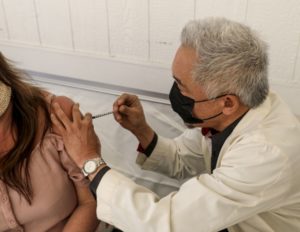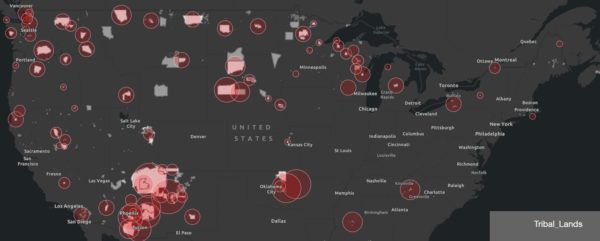IHS Successfully Acquired Medical Supplies Despite High Demand

Ken Wong, a registered nurse with the Nevada National Guard’s Department of Emergency Management, administers the Janssen vaccine to a member of the Paiute Indian Tribe at the mobile vaccination unit site in Las Vegas last April.
WASHINGTON — From the start of the pandemic, American Indians and Alaskan Natives have been disproportionately impacted by the virus. New data released last month by Johns Hopkins University (JHU) helps visualize that disparity, which has been blamed on a higher rate of preexisting conditions and poorer health infrastructure.
At the same time, a new report suggests that the Indian Health Service (IHS) was able to bridge many of those infrastructure gaps during the pandemic, at least when it came to acquiring medical supplies during a time of unprecedented demand. In addition, vaccination rates have been higher than average in those communities. (See accompanying article.)
According to the national Centers for Disease Control and Prevention, America’s indigenous population is 1.7 times more likely to contract COVID-19, 3.5 times more likely to be hospitalized, and 2.7 times more likely to die from the virus. Last month, JHU’s Coronavirus Resource Center launched a data-driven map that tracks the impact of the virus across American Indian and Alaska Native communities, mapping cases and deaths, as well as vaccinations, on Tribal lands.
The map was created in partnership with Indian Country Today, an independent news service that covers Tribal and Natives news throughout the Americas. When the first COVID cases appeared in the Navajo Nation, managing editor Jourdan Bennett-Begaye began a spreadsheet that tracked the virus’s spread.
While IHS eventually began doing similar tracking, it was not necessarily collecting all the data available, Bennett-Begaye explained in an editorial for Indian Country Today last month. IHS facilities are required to report their data, but tribally owned and operated facilities are not. Bennett-Begaye and her team knew the communities well—the websites to check, the social media to follow and the people they could call to get more robust COVID-19 numbers.
“I wanted this data to come directly from tribes and publicly available data. I also wanted to give the data back to them to use,” Bennett-Begaye wrote.
Bennett-Begaye’s publicly-available spreadsheet came to the attention of Talia Quandelacy, PhD, a Native infectious disease epidemiologist with ties to the CDC and JHU. Quandelacy began mapping the data and eventually put the Indian Country Today team in touch with JHU.
Interactive Map
A year and a half later, the JHU Coronavirus Resource Center was able to launch the Tribal Lands Interactive Map. The map currently does not include information from Urban Indian populations, but researchers hope to eventually expand the data to include them.
One challenge that Native-serving health facilities shared with every other healthcare system during the pandemic was a sharp increase in the demand for medical supplies during a time of extreme supply chain disruptions. According to a recent Government Accountability Office (GAO) report, the IHS succeeded in meeting that demand by leveraging emergency contracting authority and being flexible with where they got their supplies. However, procurement officials did not always notice whether those supplies arrived on time.
From 2017 through February 2020, IHS’s annual medical supply contracts hovered between $125 and $150 million. Between February 2020 and July 2021, IHS was required to purchase an additional $206 million in pandemic-related products.
IHS’s demand for medical supplies peaked twice during the pandemic. The first time was in April 2020, when the driver was the need for personal protective equipment (PPE) such as masks and gloves. The second peak was in January 2021, and involved lab analyzers, test kits and reagents to test COVID-19 samples.
IHS responded to its medical supply challenges by making good use of flexibilities built into the federal acquisition rules in the event of an emergency.
For example, during previous years, only about 19% of IHS contracts were awarded noncompetitively. During the pandemic, that rose to 74%, with IHS citing “unusual and compelling urgency,” in which the government would suffer harm if it limited the sources from which agencies obtain supplies. The same clause allowed IHS to ignore restrictions of the Buy American Act, which establishes a preference for domestic products over foreign-bought ones.
“IHS officials told us that awarding contracts quickly was important because the medical supply market was volatile, and the availability of items could rapidly change,” the GAO report states. “In addition, some existing vendors were unable to deliver medical supplies at the time.”
One of the drawbacks of the scramble to meet this increased demand is that IHS procurement officials did not always notice when products arrived late to IHS facilities. For example, one vendor delivered 20% of its Level 2 gowns and 35% of its Level 3 gowns a month late.
“Officials attributed this oversight to the spike in volume, as well as the urgency of procurements during a pandemic,” the report states. “IHS officials told us that they began taking intermediate steps to improve tracking of products during 2020; the agency is currently obtaining new software to improve contractor oversight.”


